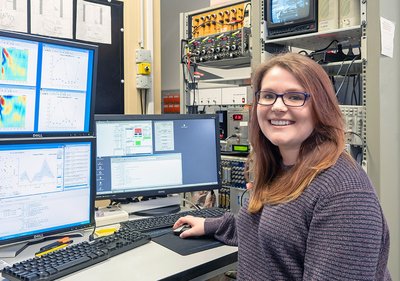Information for PhD students
Currently about 40 doctoral students are working at LIN. The doctorate is awarded by the Otto-von-Guericke-University Magdeburg. Further information on enrolment can be found on the OVGU Website .
Doctorate to Dr. rer. nat.
At the LIN, there is a structured PhD program. PhD agreements regulate the rights and duties of doctoral students and supervisors: from mentoring to fixed and transparent remuneration. Thesis Committees advise the doctoral candidates and support the projects, which can be co-designed by the PhD candidates in research proposals.
Doctorate to Dr. med.
We offer the opportunity of a doctorate in the scientific field to highly motivated students of human medicine. Due to the good supervision situation at LIN and the selection of interesting medical topics, doctoral students can work on their own projects – assuming good time management.
PhD Representatives
The PhD representatives chosen by the doctoral candidates represent the interests of all PhD students. They try to make the start at LIN as easy as possible. Whether you need help in the lab or have questions about your doctorate, they are always available as a contact person. The social events they organise are also real highlights.
Our PhD Representatives can be contacted by e-mail: phd.representatives(at)lin-magdeburg.de.
Doctorate in Magdeburg
There are numerous education programs at the Otto von Guericke Graduate Academy. It is also possible to participate in mentoring programmes and network meetings. The CBBS Graduate Program was created especifically for the neurosciences. More than 100 doctoral candidates are taking part at the moment.
This is what PhD students at LIN tell about their doctorate:
What are you working on right now?
I use optogenetics to control calcium channel dynamics in the synapses of the auditory cortex. I make calcium channels sensitive to light so that they open when it’s present. This causes everything stored in the synapse to be continuously released and makes the synapse deterministic.
What do you need it for?
This tool is being developed to better understand the basic mechanism and network connectivity in the auditory cortex and the impact of calcium dynamics. I will be able to target specific cell types and cortical areas to characterize their role in auditory learning and behaviour.
How did you get to LIN?
After a Bachelor in Psychology, I was interested in studying in Germany and I was accepted to an integrated neuroscience program in OVGU. From there I became fascinated by the balance of excitation and inhibition in cortical networks and found my place in the CortXplorers at the LIN.
How did you get to LIN?
After my master's degree in Tübingen I was looking for an interesting project for my doctoral thesis. It was also important for me to be able to learn as many new techniques as possible. Because of the good conditions, I finally chose the LIN.
What are you working on right now?
I work in the research group Neuroplasticity and investigate transport mechanisms of signalling proteins in neurons. In order to make the proteins visible, I couple them with another protein that can fluoresce and is therefore detectable. Using a microscope, I can see how they move together.
What do you need it for?
Neurons are in a permanent contact with their environment - they receive different signals and sometimes have to adapt to new requirements. However, with many neurological and psychiatric diseases, this doesn´t work any longer.
How did you get to LIN?
After completing my master's degree in neuropsychology in Italy, I spent a year researching in two different groups in Germany before joining the LIN and doing my doctorate in the Neurocognitive Development research group.
What are you working on right now?
I'm investigating the involuntary attention in children. In my last experiment, I tested children from 7 to 10 years old throug EEG and eye tracker. They watched a video while distracting sounds were presented. We are interested, for example, in how they can be distracted by emotions.
What do you need it for?
The development of involuntary attention in children has been little studied yet, although attention control is necessary for many learning processes. We also compare different methods to study attention.
SimpleNeuro Blog
The project simpleneuro.org was launched by Marina Zempeltzi and Marcel Brosch and many new faces have since joined the crew. A team of around ten young researchers set on making this blog a lively one to inform about neuro topics from their point of view.
You can find them also on Twitter: @SimpleNeuro and Instagram: @simpleneuro.






